B0041VYHGW EBOK (171 page)
Authors: David Bordwell,Kristin Thompson

Ozu is a master of matching on action, but he often does so in unusual ways. For example, as Noriko and the grandmother walk toward the door of Noriko’s apartment, there is a 180° cut
(
11.50
,
11.51
).
The women’s movements are closely matched, but because the consistent camera height and distance create such similar framings, the effect at the cut is to make it seem momentarily that the pair bump into themselves. Their screen positions, left to right, are also abruptly reversed, something that is usually considered an error in continuity. A classical filmmaker would most likely avoid such an unusual cut, but Ozu uses it here and in other films as part of his distinctive style.
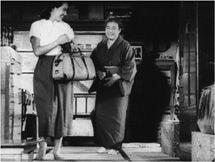
11.50 From this head-on view of Noriko and the grandmother …
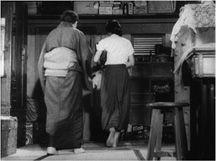
11.51 … there is a cut to a tails-on view of them.
As these examples illustrate, Ozu does not restrict his camera and editing patterns to the semicircular space on one side of the axis of action. He cuts in a full circle around the action, usually in segments of 90° or 180°. This means that backgrounds change drastically, as in both previous examples. In a Hollywood film, the camera rarely crosses the axis of action to look at the fourth wall. Because surroundings change more frequently in
Tokyo Story,
they become more prominent in relation to the action; the viewer must pay attention to setting or become confused.
The transitional shots that prolong or thwart the viewer’s expectations and the 360° space that asks us to notice surroundings can work together. When the grandparents visit a spa at Atami, the scene begins with a long shot along a hallway
(
11.52
).
Latin-style dance music plays offscreen, and several people walk through the hall. The next shot
(
11.53
)
is a long shot of another hallway upstairs, with a maid carrying a tray; two pairs of slippers are just visible by a doorway at the lower left. Next comes a medium long shot of a hallway by a courtyard
(
11.54
).
More people bustle through. A medium shot of a mah-jongg game follows
(
11.55
)
; there is the sound of talking and pieces moving about. Then Ozu cuts 180° across the axis, framing another mah-jongg table
(
11.56
).
The first table is now in the background, viewed from the opposite side. The next cut returns to the medium long shot along the courtyard hallway
(
11.57
).
In all of these shots, we have not yet seen the grandparents, who are the only major characters present at the spa. Finally, there is a medium shot of the two pairs of slippers by the door in the upper hallway
(
11.58
),
suggesting that this is the grandparents’ room. The panes of glass in the wall reflect the lively movement of the offscreen party, and the loud music and talk are still audible. A medium shot of the Hirayamas in bed, trying to sleep through the noise, finally reveals the narrative situation, and a conversation begins between the couple
(
11.59
).
For seven shots, the film slowly explores the space of the scene, gradually letting us discover the situation. The presence of the slippers in the second shot (
11.53
) is almost unnoticeable. It hints that the grandparents are there, but the revelation of their whereabouts is then put off for several more shots.
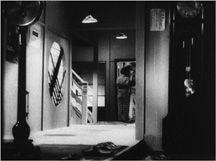
11.52
Tokyo Story.
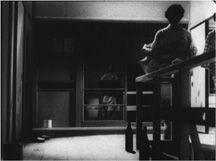
11.53
Tokyo Story.
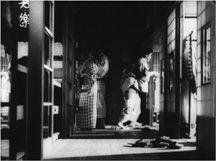
11.54
Tokyo Story.

11.55
Tokyo Story.
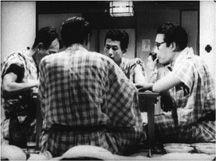
11.56
Tokyo Story.
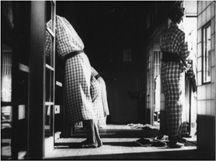
11.57
Tokyo Story.
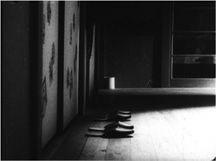
11.58
Tokyo Story.
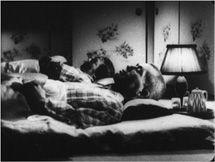
11.59
Tokyo Story.